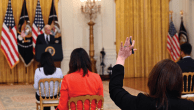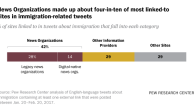Summary of Findings

The public remained focused on the unfolding environmental disaster in the Gulf of Mexico last week, while the media divided its attention between two top stories: the oil leak and controversial comments by Gen. Stanley McChrystal that led to his ouster as commander of U.S. forces in Afghanistan.
More than half of the public (53%) says they followed news about the Gulf coast oil leak more closely than any other major story. Just 7% say they followed news about the general’s comments and resignation most closely, according to the latest News Interest Index survey conducted June 24-27 among 1,001 adults by the Pew Research Center.
Since early May, the public has tracked the worsening oil spill much more closely than any other news. The story also topped coverage for the previous six weeks. Last week, the McChrystal developments, triggered by a Rolling Stone article that included critical comments about administration officials by the general and top aides, garnered comparable levels of coverage. The oil leak accounted for 23% of the newshole. News about McChrystal and President Obama’s decision to replace him made up 21%. Including the McChrystal news, reports about the war in Afghanistan accounted for 25% of the newshole, the highest level of coverage for the war since Obama announced his new strategy – including the deployment of additional troops – on Dec. 1, 2009.
Almost three-in-ten (28%) say they followed the McChrystal story very closely, slightly more than the proportion who have said they followed other Afghanistan-related stories that closely this year. Notably, there is no difference by partisanship in terms of who followed this story. Meanwhile, close to six-in-ten (56%) say they followed news about the oil leak very closely.
Views of Media Coverage of National, State Economies
The public also continues to keep a close watch on a still-struggling economy. More than a third (37%) say they followed economic news very closely last week; 12% say this was the news they followed most closel

y.
According to the Pew Research Center’s Project for Excellence in Journalism, news about the economy made up 8% of coverage last week. State and local budget problems, worsened by the troubled economy, attracted less attention from the press or the public. Just 3% say news about state and local budgets was their top story of the week. Just 1% of coverage was devoted to these topics. Still, 26% say they followed news about state and local budget problems very closely.
Asked about the accuracy of economic coverage, 36% say news reports present the U.S. economy “about the way it really is.” Close to three-in-ten (28%) say news reports make the national economy seem worse than it really is and 23% say they make it seem better than it really is.
People have greater confidence in the press’s portrayal of their state economies: 55% say news reports portray the economy in their state about as it really is, 20% say worse than it really is and 18% say better.

Partisans differ somewhat when it comes to assessing press coverage of the national economy, but not state economies. Republicans are more likely (32%) than Democrats (17%) or independents (22%) to say the press makes the economy seem better than it is. A plurality of Democrats (44%) says news reports portray the economy as it really is, slightly more than the percentages of Republicans (35%) and independents (34%) who say this.
There are no differences by gender when it comes to perceptions of media coverage of the national economy, but women are more likely to credit the press with portraying their state economy as it really is than are men (60% versus 50%).
Perceptions of press coverage of the national economy have shifted substantially since late October 2008, the last time the question was asked. In the waning months of George W. Bush’s presidency, with the global economic crisis rapidly worsening, 45% thought news reports were presenting the national economy about as it really was and 40% said they thought news reports were making the economy seem worse than it actually was. Just 11% said the media was making the economy seem better than it was.
Among partisans, Republicans today are no more likely to say the press is getting it right than they did in 2008 (35% today vs. 34% in 2008), but they are now much more likely to say the media makes the economic picture look better than it really is (32% today, 9% in 2008) and much less likely to say the media make the economy look worse (24% today, 55% in 2008).
Changes in perceptions have been more modest among Democrats and independents. Both are less likely than in 2008 to say news reports are portraying the U.S. economy as it actually is. Among Democrats that number dropped from 56% to 44%. Among independents, it dropped from 43% to 33%. Independents are now more likely than in 2008 to say the media make the economy seem better than it is (22% today, 10% in 2008).
Few Follow World Cup, Guilty Plea in Attempted Bombing of Times Square
Looking at other news, 6% say they followed the World Cup more closely than any other story last week; 14% say they followed the international soccer tournament very closely. News about the World Cup made up 2% of the news coverage last week.
Faisal Shazhad’s guilty plea in connection with the May attempt to explode a car bomb in Times Square was the top story for just 1% of Americans; 18% say they followed this story very closely. Interest in the story is far lower than in early May, shortly after the incident, when 37% said they followed news about the investigation and arrests very closely and 13% named this the story they followed most closely. The Times Square guilty please took up 2% of last week’s newshole.

These findings are based on the most recent installment of the weekly News Interest Index, an ongoing project of the Pew Research Center for the People & the Press. The index, building on the Center’s longstanding research into public attentiveness to major news stories, examines news interest as it relates to the news media’s coverage. The weekly survey is conducted in conjunction with The Project for Excellence in Journalism’s News Coverage Index, which monitors the news reported by major newspaper, television, radio and online news outlets on an ongoing basis. In the most recent week, data relating to news coverage were collected June 21-27, and survey data measuring public interest in the top news stories of the week were collected June 24-27, from a nationally representative sample of 1,001 adults.
About the News Interest Index
The News Interest Index is a weekly survey conducted by the Pew Research Center for the People & the Press aimed at gauging the public’s interest in and reaction to major news events. This project has been undertaken in conjunction with the Project for Excellence in Journalism’s News Coverage Index, an ongoing content analysis of the news. The News Coverage Index catalogues the news from top news organizations across five major sectors of the media: newspapers, network television, cable television, radio and the internet. Each week (from Monday through Sunday) PEJ compiles this data to identify the top stories for the week. (For more information about the Project for Excellence in Journalism’s News Coverage Index, go to www.pewresearch.org/pewresearch-org/journalism.) The News Interest Index survey collects data from Friday through Monday to gauge public interest in the most covered stories of the week.
Results for this survey are based on telephone interviews conducted under the direction of Princeton Survey Research Associates International among a national sample of 1,001 adults living in the continental United States, 18 years of age or older, from June 24-27, 2010 (671 respondents were interviewed on a landline telephone, and 330 were interviewed on a cell phone, including 137 who had no landline telephone). Both the landline and cell phone samples were provided by Survey Sampling International. Interviews were conducted in English.
The combined landline and cell phone sample are weighted using an iterative technique that matches gender, age, education, race, Hispanic origin, region, and population density to parameters from the March 2009 Census Bureau’s Current Population Survey. The sample is also weighted to match current patterns of telephone status based on extrapolations from the 2009 National Health Interview Survey. The weighting procedure also accounts for the fact that respondents with both landline and cell phones have a greater probability of being included in the combined sample and adjusts for household size within the landline sample. Sampling errors and statistical tests of significance take into account the effect of weighting. The following table shows the error attributable to sampling that would be expected at the 95% level of confidence for different groups in the survey:
In addition to sampling error, one should bear in mind that question wording and practical difficulties in conducting surveys can introduce error or bias into the findings of opinion polls.





